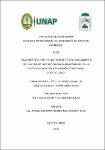| dc.contributor.advisor | Flores Malaverry, Jorge Agustín | |
| dc.contributor.author | Sevillano Daza, Kathya Elizabeth | |
| dc.date.accessioned | 2023-09-07T18:31:10Z | |
| dc.date.available | 2023-09-07T18:31:10Z | |
| dc.date.issued | 2022 | |
| dc.identifier.other | 638.1 S45 2022 | |
| dc.identifier.uri | https://hdl.handle.net/20.500.12737/9323 | |
| dc.description.abstract | The study was called, preliminary diagnosis on ethno-knowledge of the breeding of native Amazonian bees in the Momón river micro-basin. Punchana. Loreto. 2021. Its objectives were: Evaluate the knowledge about native Amazonian bees and honey production, of the inhabitants of 2 communities in the Momón river micro-watershed. The non-experimental research designation was used. The research work is descriptive-transversal. There was a simple probabilistic sample of 20 people, 10 per community with experience in honey extraction. The conclusions that were reached with the work were: On the traditional knowledge of the breeding of native bees, these people have high knowledge (40%) to regular (40%), of the same; they classify the bees with simple names, those that have a sting and sting and others that are the opposite, whose development habitat is in the trunks of trees, bushes and on the ground or at the foot of trees and feed on juices or nectars and pollen from plant species for honey production (100%). They refer that their reproduction is sexual, between the queen and the drones and they make seasonal movements in search of food, which they obtain from fruit and forest species, bread crops and ornamental flowers (100%). They can extract from 20 to 25 kg of honey annually from a hive located in the natural environment. They also consider that the number of beehives in the area is decreasing, due to deforestation and climate change. The breeding of bees in family gardens and the planting of different plant species should be proposed in the same area. | en_US |
| dc.description.abstract | El estudio se denomino, diagnóstico preliminar sobre etnoconocimiento de la criá de abejas nativas amazónicas en la microcuenca del rio Momón. Punchana. Loreto. 2021. Sus objetivos fueron: Evaluar el conocimiento sobre abejas nativas amazónicas y la producción de miel, de los pobladores de 2 comunidades en la microcuenca del río Momón. Se utilizó el diseño de investigación no experimental. El trabajo de investigación es descriptivo-transversal. Se tuvo una muestra probabilística simple, de 20 personas, 10 por comunidad con experiencia en la extracción de miel. Las conclusiones que se llegaron con el trabajo fueron: Sobre el conocimiento tradicional de la cría de abejas nativas, estas personas tienen alto conocimiento(40%) a regular (40%), de las mismas; clasifican a las abejas con denominaciones simples, las que poseen aguijón y pican y otras que son todo lo contrario, cuyo habitát de desarrollo son en los troncos de árboles, arbustos y sobre la tierra o al pie de árboles y se alimentan de jugos o néctares y polen de especies vegetales para la producción de miel (100%). Refieren que su reproducción es sexual, entre la reina y los zánganos y estas realizan movimientos estacionales en busca de alimento, el cual lo obtienen de especies frutales, forestales, cultivos de pan llevar y flores ornamentales (100%). Pueden extraer de 20 a 25 kg de miel anualmente de una colmena situada en el medio natural. Consideran asi mismo que el número de colmenas en la zona esta bajando, debido a la deforestación y cambio climático. Se debe proponer la cría de las abejas en los huertos familiares y la siembra de diferentes especies vegetales, en esa misma área. | es_PE |
| dc.format | application/pdf | es_PE |
| dc.language.iso | spa | es_PE |
| dc.publisher | Universidad Nacional de la Amazonía Peruana | es_PE |
| dc.rights | info:eu-repo/semantics/openAccess | * |
| dc.rights.uri | https://creativecommons.org/licenses/by/4.0/ | * |
| dc.subject | Apicultura | es_PE |
| dc.subject | Conocimientos tradicionales | es_PE |
| dc.subject | Abejas | es_PE |
| dc.subject | Microcuenca | es_PE |
| dc.subject | Río Amazonas | es_PE |
| dc.title | Diagnóstico preliminar sobre etnoconocimiento de la cría de abejas nativas amazónicas en la microcuenca del río Momón. Punchana. Loreto. 2022 | es_PE |
| dc.type | info:eu-repo/semantics/bachelorThesis | es_PE |
| thesis.degree.discipline | Ingeniería en Gestión Ambiental | es_PE |
| thesis.degree.grantor | Universidad Nacional de la Amazonía Peruana. Facultad de Agronomía | es_PE |
| thesis.degree.name | Ingeniero(a) en Gestión Ambiental | es_PE |
| dc.subject.ocde | https://purl.org/pe-repo/ocde/ford#4.02.02 | es_PE |
| renati.author.dni | 72198120 | |
| renati.advisor.orcid | https://orcid.org/0000-0002-1125-8600 | |
| renati.advisor.dni | 05203391 | |
| renati.type | https://purl.org/pe-repo/renati/type#tesis | es_PE |
| renati.discipline | 521236 | es_PE |
| renati.level | https://purl.org/pe-repo/renati/level#tituloProfesional | es_PE |
| renati.juror | Manrique del Aguila, Julio Abel | |
| renati.juror | Yalta Vega, Ronald | |
| renati.juror | Chavez Vasquez, Rafael | |
| dc.publisher.country | PE | es_PE |





